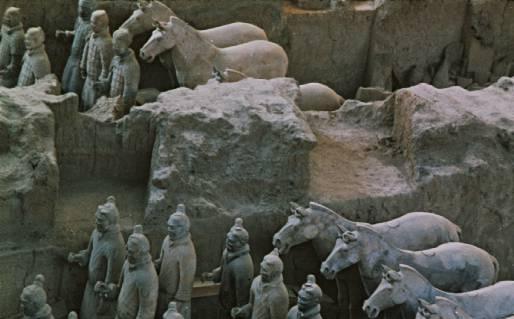(259-210 bc), first emperor of China (221-210 bc) and founder of the Qin (Ch'in) dynasty (221-206 bc), which gave its name to China. Although the dynasty fell apart four years after Qin Shihuangdi’s death, many aspects of its system of government endured in imperial China for more than 2,000 years.
The future emperor was born Qin Zheng in Qin, a state in northern China. At age 13, he succeeded his father, Qin Zichu, king of Zhuang Xiang, as ruler of the Qin state and took the title King Zheng (sometimes spelled Cheng). At the time he ascended the throne, Qin was the strongest of China’s seven so-called Warring States, which were remnants of the Zhou (Chou) dynasty, a feudal regime that ruled China from around 1027 bc until 256 bc. Over the centuries, nobles had become rulers of independent kingdoms and had taken up arms against one another. Beginning in the 4th century bc, the Qin rulers who preceded King Zheng implemented reforms designed to strengthen the government of the Qin state. Military and administrative appointments, which had previously been determined by noble birth, were now decided by merit. Farmers, no longer enslaved servants, were allowed to own their land, and production increased. The Qin government strictly enforced laws issued by the rulers, and for this reason it is often described as Legalist.
Although King Zheng had ascended the throne in 247 bc, officials from his father’s government continued to rule the Qin state until Zheng was declared of age in 238 bc. Upon assuming control, Zheng began planning the conquest of the other six states. In 230 bc Qin defeated Han, the weakest of the states, and within nine years it had conquered the others.
In 221 bc King Zheng, having completed the unification of China by military force, proclaimed himself Qin Shihuangdi (First Qin Emperor). As the first ruler to govern a truly unified China, Qin Shihuangdi imposed an extraordinary series of measures designed to reinforce the authority of the central government. A new system replaced feudal kingdoms with 36 (later 42) jun (provinces) that were run by appointed officials. To facilitate trade and communication, the government standardized weights and measures and created a uniform writing system for the Chinese language. The regime maintained tight control over information by destroying books or removing them from circulation (books about agriculture, divination, and medicine were exceptions), and by putting hundreds of dissenting scholars to death. The government also built an extensive network of new roads and canals to improve communication and transportation. To protect China’s northern frontier, the government constructed fortifications, thereby creating a precedent for the later network of walls that became known as the Great Wall.
The extent of Qin Shihuangdi's personal role in these measures is hard to determine. Records suggest that he was energetic and intelligent, but the emperor’s minister of state, Li Si (Li Ssu), is generally given most of the credit for shaping the dynasty. Qin Shihuangdi survived at least three assassination attempts and in time became preoccupied with a quest for immortality. He consulted magicians and traveled around the empire in search of a potion that would bring him eternal life. He also ordered the construction of a massive tomb near the modern city of Xi’an (Sian). Excavation of the tomb, which began in 1974, uncovered thousands of life-size terra cotta soldiers and horses positioned to protect Qin Shihuangdi from threats in the afterlife. Some of the emperor's concubines and the workers who had built the mausoleum were buried with him to keep secret the tomb’s precise location.
For centuries, most Chinese scholars condemned Qin Shihuangdi as a heartless tyrant whose harsh Legalist doctrines ignored the teachings of Chinese philosopher Confucius (see Chinese Philosophy). Some Western evaluations suggest that these scholars exaggerated the emperor's flaws and excesses to conceal the degree to which subsequent dynasties carried forward Qin Shihuangdi's legacy. Although later Chinese emperors based their governments on Confucian ethics, they nonetheless followed the dynasty’s examples of a unified China, government through bureaucratic administration, and application of harsh laws when the occasion demanded.
